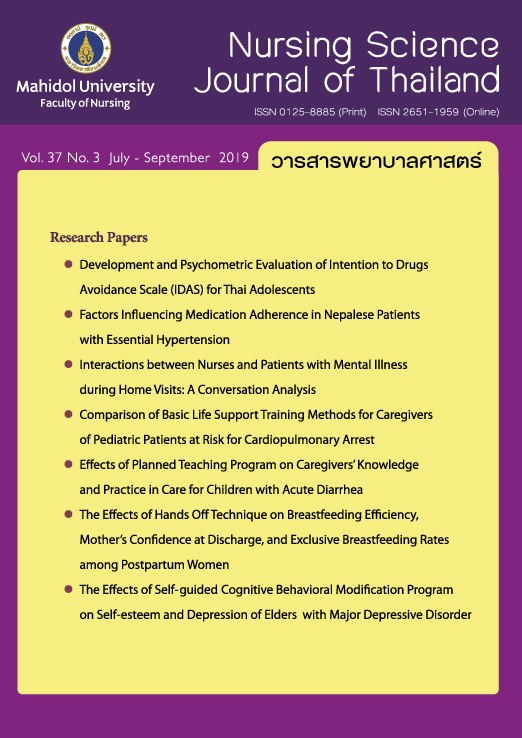Interactions between Nurses and Patients with Mental Illness during Home Visits A Conversation Analysis
Main Article Content
Abstract
Purpose: To explore how nurses and patients with mental illness communicate with each other in natural interactions during an annual home visit.
Design: Qualitative observational study.
Methods: An observational study was conducted during home visits at patients’ homes in a northeastern province of Thailand in 2017 and the data were 32.2 hours of videotape recording with 4 nursing staff and 6 patients with mental illness. Conversation analysis technique was used to analyze nurse-patient interactions.
Main findings: Turn-taking or ordering of speakers was frequently controlled and allocated by the nurses. However, patients sometimes interrupted the conversation and had very little input because most questions asked were closed-ended. Patients used pause, silence techniques and changed the subject to avoid their dispreferred responses.
Conclusion and recommendations: Theoretically, patient-centered communication model should be focused for nurse-patient interaction, but in this study nurses controlled the conversation mostly about the topic of nursing tasks. It is essential to provide a special training program for nursing staff to develop patient-centered communication skills during home visits.
Article Details
Copyright Notice: Nursing Science Journal of Thailand has exclusive rights to publish and distribute the manuscript and all contents therein. Without the journal’s permission, the dissemination of the manuscript in another journal or online, and the reproduction of the manuscript for non-educational purpose are prohibited.

Disclaimer: The opinion expressed and figures provided in this journal, NSJT, are the sole responsibility of the authors. The editorial board bears no responsibility in this regard.
References
2. Grabowski DC, Aschbrenner KA, Rome VF, Bartels SJ. Quality of mental health care for nursing home residents: a literature review. Med Care Res Rev. 2010;67(6):627-56.
3. Ammerman RT, Putnam FW, Bosse NR, Teeters AR, Van Ginkel JB. Maternal depression in home visitation: a systematic review. Aggress Violent Behav. 2010;15(3):191-200.
4. Kane JM, Kishimoto T, Correll CU. Non-adherence to medication in patients with psychotic disorders: epidemiology, contributing factors and management strategies. World Psychiatry. 2013;12(3):216-26.
5. Videbeck SL. Psychiatric-mental health nursing. 6th ed. Philadelphia, PA: Wolters Kluwer Health/Lippincott Williams & Wilkins; 2014. 652 p.
6. Jones A. Nurses talking to patient: exploring conversation analysis as a means of researching nurse-patient communication. Int J Nurs Stud. 2003;40(6):609-18.
7. Sefi S. Health visitors talking to mothers. Health Visit. 1988;61(1):7-10.
8. Cornaggia CM, Di Rosa G, Polita M, Magaudda A, Perin C, Beghi M. Conversation analysis in the differentiation of psychogenic nonepileptic and epileptic seizures in pediatric and adolescent settings. Epilepsy Behav. 2016;62:231-8. doi: 10.1016/j.yebeh.2016.07.006.
9. Hakimnia R, Holmstrom IK, Carlsson M, Hoglund AT. Exploring the communication between telenurse and caller: a critical discourse analysis. Int J Qual Stud Health Well-being. 2014;9:24255.doi: 10.3402/qhw.v9.24255.
10. Dowell A, Stubbe M, Macdonald L, Tester R, Gray L, Vernall S, et al. A longitudinal study of interactions between health professionals and people with newly diagnosed diabetes. Ann Fam Med. 2018;16(1):37-44.
11. Mayor E, Bietti L. Ethnomethodological studies of nurse-patient and nurse-relative interaction: a scoping review. Int J Nurs Stud. 2017;70:46-57.
12. Holloway I, Wheeler S. Qualitative research in nursing and healthcare. 3rd ed. West Sussex, UK: Wiley-Blackwell; 2010. 304 p.
13. Sidnell J. Conversation analysis: an introduction. West Sussex, UK: Wiley-Blackwell; 2010. 376 p.
14. Sacks H, Schegloff EA, Jefferson G. A simplest systematics for the organization of turn-taking in conversation. Language.194;50(4):696-735.
15. Drew P, Heritage J. Analyzing talk at work: an introduction. In: Drew P, Heritage J. editors. Talk at work: interaction in institutional settings. Cambridge: Cambridge University Press; 1992. 65 p.
16. Tapanya S. Psychology in medical settings in Thailand. J Clin Psychol Med S. 2001;8(1):69-72.
17. Kitreerawutiwong N, Jordan S, Hughes D. Facility type and primary care performance in sub-district health promotion hospitals in Northern Thailand. PLoS One. 2017;12(3):e0174055 doi: 10.1371/journal.pone.0174055.
18. Jefferson G. Glossary of transcript symbols with an introduction. In: Lerner GH, editor. Conversation analysis studies from the first generation. Amsterdam/Philadelphia: John Benjamins; 2004. p.13-31.
19. Chadchaidee TL. Thailand in my youth. Bangkok: BooksMango; 2014. 172 p.
20. Wynn R. Provider-patient interaction: a corpus-based study of doctor-patient and student-patient interaction. 6th ed. Kristiansand, NO: Hoyskoleforlaget Norwegian Academic Press; 1999. 292 p.
21. Zimmerman DH, West C. Sex roles, interruptions and silences in conversation. In: Thorne B, Henley N. editors. Language and sex: difference and dominance. Rowley, MA: Newbury House; 1975. p.105-129.
22. Aquino AM. Speech and oral communication for nursing. Manila: Rex Book Store; 2008. 386 p.
23. Borg J. Talk ability: discover the secrets of effective conversation. London: Pearson Business; 2016. 256 p.
24. Gardezi F, Lingard L, Espin S, Whyte S, Orser B, Baker GR. Silence, power and communication in the operating room. J Adv Nurs. 2009;65(7):1390-9.
25. Peplau HE. Interpersonal relation in nursing: a conceptual frame of reference for psychodynamic nursing. New York, NY: Springer; 1991. 360 p.


